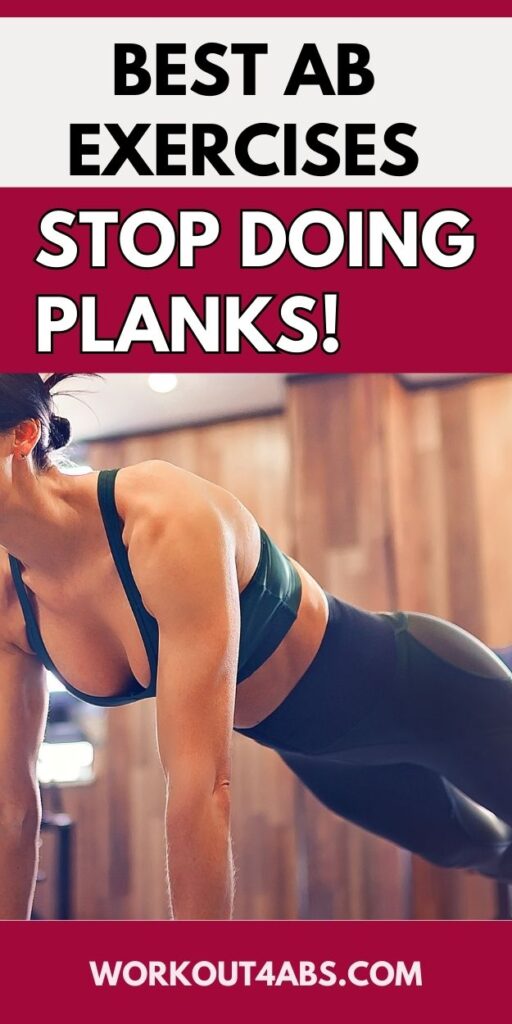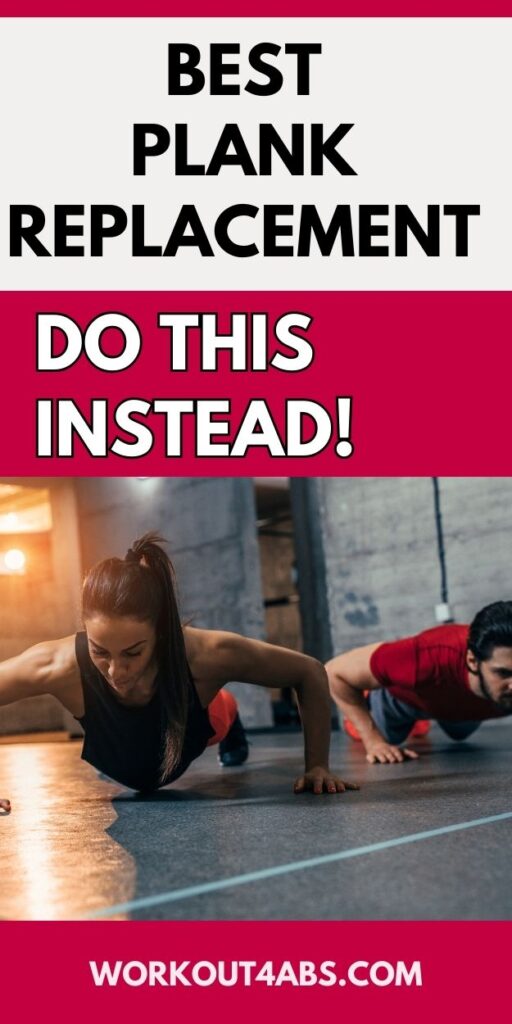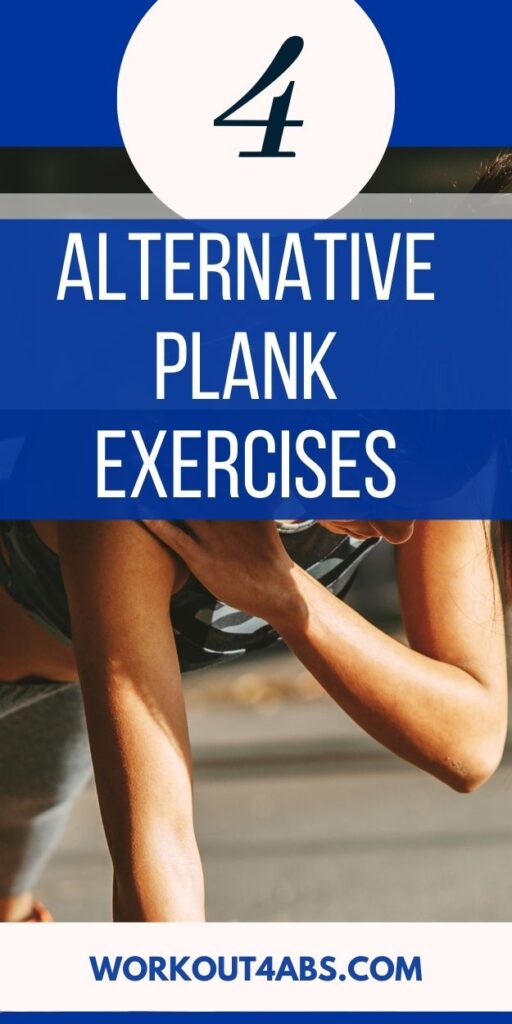Are you looking for a core exercise better than plank? Discover why continuing planks with poor technique could be doing more harm than good. Delve into how improper form can lead to injuries and back pain, and learn why prioritizing correct posture is the key to maximizing the benefits of this core-strengthening exercise. Also, discover an alternative way to train that’s much better than the traditional plank.
Planks Are Outdated! Best Replacement Exercise (Guaranteed)!!!
If you enjoyed these tips, please save this pin to your Pinterest Board.

Planks with Movement
Incorporating movement into plank exercises can add an extra challenge to your core workout while still maintaining good posture. Here’s how to perform planks with movement variations like mountain climbers, spider crawls, scissor kicks, and leg lifts to the side, all while ensuring proper form:
1. Mountain Climbers:
- Start in a high plank position with your hands directly under your shoulders and your body in a straight line from head to heels.
- Engage your core muscles to stabilize your body.
- Alternate bringing your knees toward your chest in a running motion, as if you’re climbing a mountain.
- Keep your hips down and your back flat throughout the movement.
- Maintain a controlled pace to avoid bouncing or jerking movements.
2. Spider Crawls:
- Begin in a high plank position with your hands under your shoulders and your body aligned.
- Lift your right foot slightly off the ground and bring your right knee toward your right elbow, aiming to touch or get as close as possible.
- Return your right leg to the starting position.
- Repeat the same movement on the left side, bringing your left knee toward your left elbow.
- Keep your hips stable and avoid excessive twisting of the torso.
3. Scissor Kicks:
- Start in a high plank position with proper hand placement and core engagement.
- Lift your right foot a few inches off the ground, then lift your left foot a bit higher, creating a scissor-like motion.
- Alternate kicking your legs up and down in a controlled manner.
- Focus on keeping your hips stable and maintaining a straight line from head to heels.
- Engage your core to prevent your lower back from arching excessively.
4. Leg Lifts to the Side:
- Begin in a high plank with your hands under your shoulders and core engaged.
- Lift your right leg off the ground, keeping it straight, and move it out to the side while keeping your hips steady.
- Lower your leg back down to the starting position.
- Repeat the movement with your left leg.
- Avoid letting your hips sag or twist during the leg lifts.
Important Tips for All Movements:
- Maintain a neutral spine and avoid letting your lower back sag or arch.
- Keep your core muscles engaged throughout the entire movement to stabilize your body.
- Focus on controlled and deliberate movements rather than speed.
- Breathe steadily throughout the exercises.
- Start with a manageable number of repetitions and sets, gradually increasing as your strength and endurance improve.
- If you experience any discomfort or pain, stop the exercise and reassess your form.
Incorporating these movement variations into your plank routine can help challenge different muscle groups while maintaining proper posture and alignment. Always prioritize quality over quantity, and make sure to consult with a fitness professional if you’re unsure about your form or if you have any underlying health concerns.
STOP Doing Planks!
If you enjoyed these tips, please save this pin to your Pinterest Board.

How to Do Planks Correctly
Planks are a popular and effective exercise for strengthening the core muscles, but performing them with poor technique can lead to several issues that can worsen your posture and potentially cause discomfort or pain. Here’s why you should stop doing planks with poor technique:
- Poor Technique and Posture: When you perform planks with improper technique, your body might not be aligned correctly, causing your posture to suffer. For instance, if you allow your hips to sag or your lower back to arch excessively, you’re putting undue stress on your spine and surrounding muscles. This can lead to discomfort, pain, and even long-term postural issues if not corrected.
- Strain on Lower Back: Incorrect plank technique, such as allowing your hips to sag, places a disproportionate amount of pressure on your lower back muscles. This can strain the lumbar region and lead to discomfort or even back pain over time.
- Engaging the Wrong Muscles: Planking with poor technique can cause you to rely more on muscles in your shoulders and arms rather than your core muscles. This defeats the purpose of the exercise, as planks are primarily designed to target the core. Overusing the wrong muscles can lead to imbalances and potential injuries.
Now, let’s look at how performing planks correctly can help and how improper hip flexor activation can lead to back pain:
- Proper Technique and Core Activation: When done correctly, planks engage the deep core muscles, including the transverse abdominis and obliques, to stabilize your spine and maintain proper alignment. Engaging these muscles helps improve posture, reduce strain on the lower back, and prevent injury.
- Quads and Hip Flexor Activation: While planks primarily focus on the core, they also engage other muscle groups to stabilize the body. The quads and hip flexors play a role in maintaining a straight line from head to heels during a plank. However, overemphasis on hip flexor engagement due to poor form can cause these muscles to become overly tight and potentially contribute to lower back discomfort.
- Hip Flexors and Back Pain: Hip flexors are a group of muscles that connect your upper leg to your hip. When you excessively activate these muscles during a plank, they can become tight and pull on the pelvis, leading to an anterior pelvic tilt. This misalignment can strain the lower back, causing discomfort or pain.
In summary, performing planks with proper technique is crucial to avoid exacerbating existing posture issues, straining the lower back, and engaging the wrong muscle groups. By focusing on maintaining a straight line from head to heels, engaging the core muscles, and avoiding excessive hip flexor activation, you can enjoy the benefits of planks without the risk of back pain or postural problems. If you’re unsure about your technique, consider seeking guidance from a fitness professional to ensure you’re performing planks correctly and safely.
If you enjoyed these tips, please save this pin to your Pinterest Board.

Home › Low Impact Exercises ›Core Exercise Better Than Plank